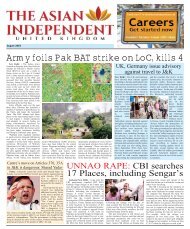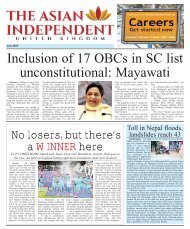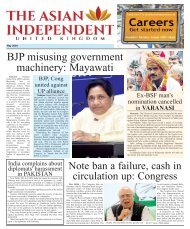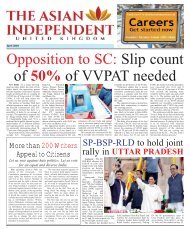September 2018
Create successful ePaper yourself
Turn your PDF publications into a flip-book with our unique Google optimized e-Paper software.
www.theasianindependent.co.uk<br />
What the Celebration of<br />
Asian Games Medalists Tells<br />
Us About Indian Society<br />
In the just concluded Asian<br />
Games at Jakarta-Palembang,<br />
India finished eighth with their<br />
best ever medals tally. This<br />
should be lauded. What is worrying,<br />
however, is the focus on<br />
some athletes who come from<br />
humble backgrounds and<br />
achieved what was considered<br />
impossible for their social<br />
class, because of the absence of<br />
training, equipment and other<br />
requirements necessary for<br />
achieving excellence in sports.<br />
The internet has been alight<br />
with stories of athletes like<br />
By<br />
Shah Alam Khan<br />
Swapna Barman, Dharun<br />
Ayyasamy, Hima Das, Vismaya<br />
Velluva Koroth and Dutee<br />
Chand, enumerating the hardships<br />
they faced, the poverty<br />
they fought and yet pursued<br />
their dream of making it big on<br />
the international sports scene.<br />
These star performers overcoming<br />
social stockades is<br />
nothing less than a miracle,<br />
more so in a country which<br />
thrives on inequality and biases<br />
of caste and class. We should<br />
all put our hands together and<br />
give them a standing ovation.<br />
Having said this, appreciation<br />
of overcoming social misfortune<br />
by some athletes – as is<br />
visible in conventional and<br />
social media – needs deeper<br />
evaluation. As a member of<br />
civil society, this applause for<br />
the disadvantaged makes me<br />
worried, if not derisive. In his<br />
book, Racism and White<br />
Denial in the Age of Obama,<br />
American thinker Tim Wise<br />
coined a term, “enlightened<br />
exceptionalism”. The book,<br />
written soon after Obama had<br />
just been elected as the first<br />
black president of the US, Wise<br />
says this ‘enlightened exceptionalism’<br />
is in itself a kind of<br />
racism (Racism 2.0). This type<br />
of racism allows for and even<br />
celebrates individual persons of<br />
color, but only because those<br />
individuals generally are seen<br />
as different from a less appealing,<br />
or even pathological black<br />
or brown rule. He feels that<br />
“enlightened exceptionalism<br />
manages to accommodate individual<br />
people of color, even as<br />
it continues to look down upon<br />
the larger mass of black and<br />
brown America with suspicion,<br />
fear, and contempt, suggests<br />
the fluid and shape-shifting<br />
nature of racism.”<br />
Applying the same logic of<br />
enlightened exceptionalism and<br />
of shape-shifting racism to the<br />
Indian society, we can explain<br />
the appreciation of many<br />
stereotypes which are thrown<br />
upon us year after year. Every<br />
year, we are made to feel awed<br />
at stories of people from humble<br />
and disadvantaged backgrounds<br />
making it big on the<br />
national or the international<br />
Dharun Ayyasamy<br />
Swapna Barman<br />
scene. Remember the Dalit girl<br />
who topped the civil services<br />
exams? Or the daughter of that<br />
ragpicker who made it to IIM?<br />
The young Kashmiri girl who<br />
made it big in kickboxing? That<br />
blind boy who made it to the<br />
medical entrance exams? In the<br />
same vein, underprivileged athletes<br />
who made the country<br />
proud at the Asian Games <strong>2018</strong>!<br />
The enlightened ‘exceptionalists’<br />
of Wise are plenty in<br />
India, probably because the<br />
fault lines of the Indian society<br />
are far larger and deeper than in<br />
America. Our social chasms<br />
intersect at multiple points and<br />
each point needs a new icon<br />
from the amongst the poor,<br />
minorities, schedule tribes,<br />
Dalits and women to lessen our<br />
guilt of having failed them<br />
through the years.<br />
The privileges of caste, capital<br />
and religion in India outweigh<br />
an individual’s efforts and<br />
hence, when somebody can<br />
overcome these to shine, be it<br />
sports, education, profession, or<br />
politics, we are quick to applaud.<br />
This applause is not for the<br />
group to which the person<br />
belongs. That group still remains<br />
an unworthy entity. It is only for<br />
the individual who could fight<br />
his/her way up from the depths<br />
in which that group survives.<br />
Those appreciating the<br />
‘exceptionalists’ are indifferent<br />
towards the fate of Dalits,<br />
Hima Das<br />
minorities or disabled. So while<br />
appreciating the Dalit civil<br />
services topper, the privileged<br />
do not feel the need to contribute<br />
towards providing equal<br />
opportunities for Dalits. On the<br />
contrary, there is a constant bid<br />
to thwart efforts towards inclusiveness<br />
(remember that antireservation<br />
rhetoric we constantly<br />
hear?). Similarly, while<br />
appreciating the kickboxing<br />
champion from Kashmir, houses<br />
are denied to Kashmiris in<br />
Delhi. The fear and contempt<br />
for Kashmiri Muslims thrives<br />
unabated. Such is the case with<br />
all those bright stars of a dark<br />
sky, who are picked up from<br />
among the ruble of the<br />
wretched and are put in a glass<br />
showcase as a measure of civility.<br />
There can’t be a more hypocritical<br />
position than this.<br />
Appreciation of well-performing<br />
individuals, whichever<br />
strata of society they come<br />
from, is not unwarranted.<br />
Appreciation of those who have<br />
defeated biases of the society is<br />
also justified, but it fails us<br />
when we look down upon the<br />
very group this individual hails<br />
from. So should we stop<br />
applauding those who have<br />
overcome the hardships of their<br />
fate and excelled? Not at all.<br />
What is required is not picking<br />
up individuals as stars from a<br />
deprived group. The solution<br />
lies in ending the exception.<br />
ASIA<br />
<strong>September</strong> <strong>2018</strong><br />
7<br />
Isuzu rolls out 2 mini-trucks for south<br />
Indian market story for biz news<br />
Bengaluru : Leading transport<br />
solutions provider SML-<br />
Isuzu on Friday rolled out two<br />
models of mini-trucks for the<br />
south Indian market.<br />
“Our new twin light commercial<br />
vehicles (LCVs) offer<br />
fuel efficiency, more driver<br />
comfort, higher uptime, minimum<br />
maintenance cost and<br />
optimum loading capacity,”<br />
Isuzu Vice-President (marketing)<br />
Junji Tonoshima told<br />
reporters here. The Chandigarhbased<br />
35-year-old joint venture<br />
between Swaraj Vehicles Ltd<br />
and Mazda Motor Corporation<br />
of Japan makes a range of LCV<br />
and ICV (intermediate commercial<br />
vehicle) trucks and buses<br />
and special application vehicles<br />
for meeting the growing needs<br />
of the growing transportation<br />
sector across the country. “We<br />
have introduced the 7-tonne<br />
mini-trucks to meet the changing<br />
customer needs, with upgradation<br />
and automation,” said<br />
Tonoshima at a preview of the<br />
twin models. The super heavy<br />
duty trucks aSamrat-17 and<br />
aSamrat-19' are priced at Rs 14<br />
lakh and Rs 17 lakh respectively,<br />
with additional features and<br />
accessories.<br />
The company also unveiled<br />
advanced telematics solution to<br />
revolutionise transportation<br />
management and 24×7 on road<br />
service support to its customers<br />
in southern India. The cabins<br />
have USB port for mobile<br />
charging, more leg room for the<br />
drivers, lighter clutch for<br />
smooth gearshift and real-time<br />
tracking device for the owners.<br />
Mazda’s associate trading<br />
house Sumitomo Corporation<br />
joined the company subsequently,<br />
buying an unspecified<br />
equity into the joint<br />
venture./Eom/215 words.
















